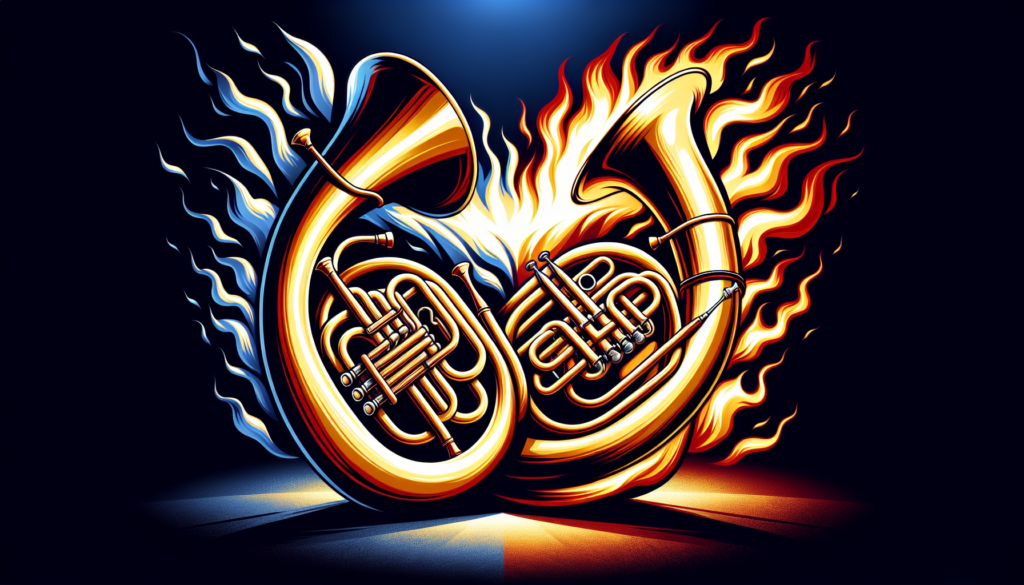If you’ve ever wondered about the differences between a sousaphone and a tuba, you’ve come to the right place! In this article, we’ll delve into the distinct characteristics and unique features of these two popular brass instruments. Whether you’re a music enthusiast or simply curious about the world of music, this comparison will help you understand the similarities and differences between the sousaphone and tuba, giving you a newfound appreciation for the complexity and beauty of these instruments. So, let’s dive in and discover the fascinating world of Sousaphone vs Tuba!

This image is property of images.unsplash.com.
Overview of Sousaphone and Tuba
Definition and Origins
The sousaphone and tuba are both brass instruments that belong to the low brass family. They are often mistaken for each other due to their similar appearances, but they have distinct differences in design and sound.
The tuba originated in the mid-19th century and was initially developed as an improvement to the older serpent instrument. It has a long history in classical music and has played a significant role in orchestras and wind bands. On the other hand, the sousaphone is a more recent addition to the musical world, first introduced in the late 19th century by the famous American bandmaster John Philip Sousa. It was specifically designed for marching bands and is often associated with traditional American styles such as jazz and marching band music.
Physical Characteristics
In terms of physical characteristics, both the sousaphone and tuba share similarities but also have distinct differences. The tuba is a large, cylindrical brass instrument with a wide bell at the bottom and a curved mouthpiece at the top. It typically stands vertically when played and has various wrap styles, which influence its overall shape and size. On the other hand, the sousaphone is an adaptation of the tuba designed for marching purposes. It features a larger bell that faces forward and is attached to a pipe that wraps around the musician’s body. This design allows for easier carrying and better projection of sound in outdoor settings.
Sound Production
Both the sousaphone and tuba produce sound through the vibration of the musician’s lips on the mouthpiece. When air is blown into the instrument, the lips vibrate, creating sound waves that resonate within the instrument’s tubing. This vibration is then amplified and projected through the bell, resulting in the characteristic deep and rich sound of the sousaphone and tuba.
Range and Register
The range and register of the sousaphone and tuba are similar, as they both have the ability to play in the low register. The tuba is known for its impressive range, spanning from the pedal tones, which are extremely low, to the upper register, where it can reach notes in the higher octaves. The sousaphone, while having a similar range, is designed primarily for playing in lower registers due to its larger size and bell shape. It produces a more focused and powerful sound in these lower registers, making it ideal for marching bands and outdoor performances.
Typical Uses
The sousaphone and tuba are used in a variety of musical contexts and genres. The tuba is a staple instrument in orchestras, wind ensembles, and brass bands, where it provides a solid foundation in the low end of the musical spectrum. It is often featured in classical compositions and symphonic works. On the other hand, the sousaphone is primarily used in marching bands and jazz bands. Its projecting sound and portable design make it ideal for outdoor performances, and it adds a distinctive character to traditional American music styles such as jazz, Dixieland, and marching band music.
Differences in Design
Shape and Size
One of the most noticeable differences between the sousaphone and tuba is their shape and size. The tuba has a vertically oriented design, with the mouthpiece at the top and the bell pointing upward. It can have various wrap styles, including the traditional upright design and the more compact front-facing design like the German rotary tuba. On the other hand, the sousaphone has a unique shape that wraps around the body of the musician. Its bell is larger and faces forward, allowing for better sound projection in outdoor settings. The overall size of the sousaphone is also larger and more unwieldy compared to the tuba.
Weight and Portability
In terms of weight and portability, the sousaphone and tuba differ significantly. The tuba, while a large instrument, is often made with lighter materials and is more compact in design. It can be carried with a shoulder harness or using a tuba stand. The sousaphone, on the other hand, is considerably heavier and bulkier due to its larger size and unique shape. It typically requires the use of a special harness that allows the weight to be distributed across the musician’s body. This makes the sousaphone less portable and more challenging to transport, making it less suitable for indoor performances or situations where mobility is required.
Playing Position
The playing position is another area where the sousaphone and tuba differentiate. When playing the tuba, the musician typically stands or sits in an upright position, with the instrument resting on a stand or held using a shoulder harness. This allows for better control and support while playing. In contrast, the sousaphone is designed to be played while marching or moving. It is carried on the shoulder or wrapped around the body, with the musician using a special harness to support its weight. This playing position allows for easier mobility and projection of sound in outdoor environments.
Wrap Style
The wrap style refers to the design of the tubing layout in the instrument. Both the sousaphone and tuba have different wrap styles that can impact their sound and playability. The tuba can come in various styles, including the traditional upright design, the rotary design, and the wrap style used in the American contrabass tuba. These design variations can affect the ergonomics of the instrument and the overall feel for the player. The sousaphone, on the other hand, has a specific wrap style designed to optimize its projection and playability in a marching band setting. The tubing is bent and wrapped around the player’s body, reducing the distance traveled by sound waves and increasing its overall volume and projection.
Sound and Tone
Sound Projection
Both the sousaphone and tuba are known for their ability to project sound effectively. However, due to their different designs, they have slight variations in sound projection. The tuba, with its vertical orientation and wide bell, achieves a more focused sound projection that can easily cut through the mix in orchestras and wind ensembles. Its sound travels upward, allowing for better blending with other instruments in a symphonic setting. In contrast, the sousaphone’s forward-facing bell and larger size are designed to project sound in outdoor environments. The sound is directed forward, allowing for better projection and clarity, making it ideal for marching bands and open-air performances.
Tonal Characteristics
The tonal characteristics of the sousaphone and tuba are similar due to their shared family and construction materials. Both instruments produce a deep, rich, and resonant sound that forms the foundation of the low brass section. They have the ability to produce warm and sonorous tones that can add depth and color to a musical ensemble. However, due to differences in design and size, the tonal quality of the sousaphone and tuba may vary slightly. The tuba is often associated with a more rounded and orchestral sound, while the sousaphone’s larger size and unique shape can give it a more focused and powerful sound, especially in the lower registers.
Timbre and Color
The timbre and color of the sound produced by the sousaphone and tuba are influenced by several factors, including the instrument’s design, the player’s technique, and the specific model and material used. The timbre, or the character of the sound produced, can vary from instrument to instrument, even within the same type. The tuba is known for its versatility in producing a range of timbres, from dark and brooding to bright and brassy. The sousaphone, with its larger size and forward-facing bell, has a slightly different timbre that can be described as more focused and powerful, adding a unique color to the overall sound of a marching band or jazz ensemble.
Range and Register
Lowest and Highest Notes
The tuba and sousaphone share similar ranges, with the tuba having a wider range due to its design variations. The tuba’s range typically spans from the pedal tones, which are extremely low and resonate in the subsonic range, to the upper register, where it can reach notes in the higher octaves. The sousaphone, while also capable of playing in these extreme low registers, is primarily designed for playing in lower registers. Its larger size and wider tubing contribute to a more focused and powerful sound in these lower registers, creating a solid foundation in marching bands and outdoor performances.
Playable Octaves
The playable octaves of both the sousaphone and tuba are similar, with the tuba having a slightly wider range. The tuba can play in multiple octaves, from the subsonic pedal tones to the upper register, where it can play alongside other brass instruments. The sousaphone, while sharing a similar range, is better suited for playing in the lower octaves due to its larger size and unique shape. It excels in producing a resonant and powerful sound in these lower registers, contributing to the overall sound and impact of a marching band or jazz ensemble.
Ability for Harmonics
Both the sousaphone and tuba have the ability to produce harmonics, which are higher-pitched tones that resonate naturally in the instrument’s tubing. Harmonics are created by manipulating the airflow and the musician’s embouchure, allowing for the production of notes beyond the traditional range of the instrument. The tuba, with its versatile range and design variations, has a greater ability to produce harmonics. The sousaphone, while not as flexible in this regard due to its larger size and marching-oriented design, can still produce harmonics to a certain extent, allowing for additional tonal possibilities in performance.

This image is property of images.unsplash.com.
Playing Technique
Embouchure and Mouthpiece
Both the sousaphone and tuba require a similar embouchure technique for producing sound. The embouchure refers to the way the musician’s lips and facial muscles engage with the mouthpiece to create vibrations. The size and shape of the mouthpiece also influence the quality and tone of the sound produced. To achieve a good embouchure on the sousaphone or tuba, the musician must form a firm but flexible seal with the lips, allowing for controlled and consistent buzzing. The size of the mouthpiece may vary depending on the specific model and player preference, but it generally requires a larger mouthpiece compared to other brass instruments.
Breathing Technique
Proper breathing technique is essential for playing the sousaphone or tuba effectively. Both instruments require the musician to take deep, diaphragmatic breaths to achieve the necessary air support for playing. This allows for sustained notes and a solid foundation of sound. Good breathing technique involves engaging the diaphragm and using the abdominal muscles to control airflow and maintain a steady stream of air. Additionally, proper breath control allows for variations in dynamics and tone color, enhancing the expressiveness and musicality of the performance.
Articulation and Tonguing
Articulation and tonguing techniques are crucial for playing musical passages with clarity and precision. Both the sousaphone and tuba utilize similar techniques for articulating notes. Articulation refers to the way the player uses the tongue to initiate the sound and separate individual notes. Proper tonguing involves precise coordination between the tongue, breath, and fingerings, allowing for clean and distinct articulation. Depending on the style of music and the musical context, different articulation techniques, such as legato, staccato, or accents, may be employed to achieve the desired effect. Mastery of articulation techniques is essential for playing complex musical passages and for blending with other instruments in an ensemble.
Performance Considerations
Ensemble Role and Contexts
The sousaphone and tuba have important roles in various musical ensembles and perform in different contexts. The tuba is a staple instrument in symphony orchestras and concert bands, where it provides a solid foundation in the low brass section. It often plays the bass or contrabass voice, harmonizing with other instruments to create a full and balanced sound. The sousaphone, on the other hand, is primarily associated with marching bands and jazz ensembles. Its powerful sound and unique shape make it ideal for outdoor performances, where it can provide the rhythmic foundation and add a distinctive character to the music.
Musical Genres and Styles
The sousaphone and tuba are utilized in various musical genres and styles. The tuba has a long history in classical music and is a standard instrument in orchestras and wind ensembles. It has been featured in a wide range of compositions, from symphonies to concertos. The sousaphone, with its association with marching bands and jazz, is commonly heard in traditional American music styles such as jazz, Dixieland, and big band. Its rhythmic and melodic capabilities make it an essential instrument for creating the infectious grooves and driving rhythms associated with these genres.
Solo and Featured Performances
While the tuba and sousaphone are primarily known for their ensemble roles, they can also be featured as solo instruments. Solo performances showcase the versatility and expressive capabilities of these instruments, allowing for virtuosic displays and the exploration of the instrument’s full potential. Some notable tuba and sousaphone compositions exist, including concertos and solo pieces specifically written for these instruments. Solo performances allow the tuba and sousaphone players to demonstrate their technical skill, musicality, and ability to captivate an audience with the unique sound and range of their instruments.

This image is property of images.unsplash.com.
Famous Players
Notable Sousaphone Players
The sousaphone has been embraced by many accomplished musicians and has a rich history of notable players. One of the most influential sousaphone players is Nat Perrilliat, who was a featured soloist in Louis Armstrong’s All-Star band. His virtuosic playing and innovative approach to the instrument helped popularize the sousaphone in jazz music. Other notable sousaphone players include Phil Frazier, the leader of the Rebirth Brass Band, and Anthony “Tuba Fats” Lacen, a highly respected New Orleans musician known for his virtuosic and soulful playing.
Acclaimed Tuba Players
The tuba has also seen virtuosic performers who have contributed to its prominence in the classical music world. One of the most acclaimed tuba players is Harvey Phillips, who played a significant role in promoting the tuba as a solo instrument. He commissioned numerous compositions and arrangements for the tuba, elevating its status and showcasing its versatility. Other highly regarded tuba players include Oystein Baadsvik, a Norwegian virtuoso known for his technical mastery and expressive performances, and Roger Bobo, a renowned American tubist who has pushed the boundaries of the instrument with his innovative techniques and interpretations.
Popularity and Availability
Availability and Accessibility
Both the sousaphone and tuba are widely available for purchase or rental from music stores and online retailers. They are considered standard instruments and are typically part of a retailer’s brass instrument inventory. However, due to their large size and specialized use in marching bands and orchestras, they may not be as commonly available as more popular instruments like the trumpet or saxophone. Nonetheless, with some research and inquiries, it is possible to find a sousaphone or tuba that suits the player’s needs and budget.
Popularity in Different Regions
The popularity of the sousaphone and tuba can vary depending on the region and cultural context. In the United States, the sousaphone holds a special place in the marching band tradition, and it is commonly seen and heard in parades, football games, and other outdoor events. The tuba, meanwhile, is highly regarded in the classical music scene and is an essential instrument in orchestras and wind ensembles. In other countries, the popularity of these instruments may vary depending on the musical traditions and genres prevalent in those regions.
Influence on Instrument Choice
The popularity of the sousaphone and tuba, and their specific uses and roles in various musical contexts, can influence the instrument choices of aspiring musicians. Those drawn to jazz, marching bands, or traditional American music genres may be more inclined to choose the sousaphone as their primary instrument. Conversely, individuals interested in classical music and orchestral playing may opt for the tuba. The musical genres and contexts in which these instruments are prevalent can shape the aspirations and career paths of young musicians and ultimately influence the instrument choices they make.

Cost and Investment
Price Range
The price range of the sousaphone and tuba can vary significantly depending on factors such as brand, quality, and condition. As brass instruments, both the sousaphone and tuba can range from affordable beginner models to high-end professional instruments. Beginner models can typically be found in the lower range of the price spectrum, with prices starting from a few hundred dollars. Mid-range or intermediate models can range from several thousand dollars, while professional-grade instruments can cost several thousand to tens of thousands of dollars. Price variations account for differences in materials, craftsmanship, and overall playability.
Value Retention
Both the sousaphone and tuba, being quality musical instruments, have the potential to retain their value over time. Well-maintained instruments from reputable manufacturers can hold their value or even appreciate in certain cases. Factors that contribute to the value retention include the instrument’s brand, condition, age, and rarity. Instruments with unique features, historical importance, or associations with famous players may hold greater value for collectors and enthusiasts. Proper maintenance, regular servicing, and care can help preserve the instrument’s condition and ensure its long-term value.
Maintenance and Upkeep Costs
Like any musical instrument, the sousaphone and tuba require regular maintenance and upkeep to ensure optimal performance and longevity. Regular cleaning, oiling, and greasing of valves and slides are essential for keeping the instrument in good working condition. The cost of routine maintenance can vary depending on factors such as the instrument’s complexity, the need for repairs or replacement parts, and the location of the service provider. It is advisable to budget for these maintenance costs to ensure that the sousaphone or tuba remains in top shape and continues to deliver exceptional performance.
Conclusion
In conclusion, the sousaphone and tuba are both versatile and integral instruments in the world of music. While they share similarities in terms of their low brass classification, the differences in their design, sound production, and playing technique make them distinctive and suited to different musical contexts. Whether you are drawn to the deep, resonant tones of the tuba in classical orchestral music or the powerful sound and marching tradition associated with the sousaphone, both instruments offer unique opportunities for expression and musical exploration. With dedicated practice and a passion for low brass, either the sousaphone or tuba can become your gateway to a world of musical possibilities.

